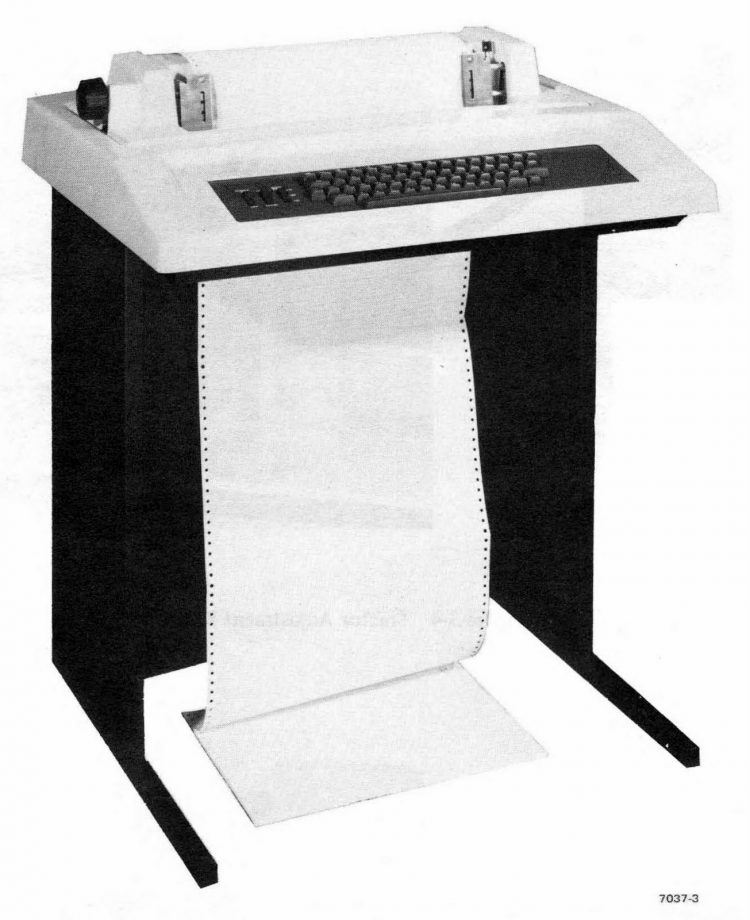What’s more, you might even be able to see in your mind’s eye how that sprocket-fed fan-fold paper used to move through the old machines!
If not — or if you just want a little refresher — here’s a look back at the technology that printed out everything from business checks to insurance forms years ago, before laser printers and inkjets became standard.

Vintage ’80s Panasonic Matrix printers (1984)
Introducing Panasonic Dot Matrix Printers. The high-quality personal and small business computer printers that truly live up to your expectations.
They combine correspondence-quality performance, compatibility and high-resolution graphics capability. Plus the quality and dependability that comes with the Panasonic name.
The 132-column KX-P1160 prints at 196 cps Elite, 165 cps Pica (half speed for correspondence quality). Performance? It’s yours with a high-resolution 16-pin head, and single-sheet front feed option.
Our 80-column version is the compact KX-P1090 — prints at 96 cps Elite, 80 cps Pica. Both models feature 8-bit parallel and optional RS-232C interfaces. Bidirectional, logic-seeking operation. And our seamless ribbon cartridge’s refresh ink reservoir, for consistent print quality … and longer ribbon life.

A vintage dot matrix printer in action
Check out this video — with sound on — for a trip back in time!

Old standard ASCII character set and code for vintage dot matrix printers

ALSO SEE: When Apple introduced the Macintosh personal computer in 1984, here’s what it could do
Vintage ’80s Toshiba dot matrix printers (1984)
Two ways to show off your IBM PC
There’s no better way to show off your IBM PC — or any other micro — than with the new line of Toshiba printers. They offer state-of-the-art features, high reliability and low price.
The new Toshiba P1351 printer has a unique high-density 24-pin dot-matrix print head. It lets you print crisp, clean letter copy at 100 cps, draft copy at 192 cps. And with the software-selectable downloading fonts, you get to pick from a variety of type styles.
The P1351 has more stuff to show. Like 180 x 180 dots-per-inch high-resolution graphics, 132-column-width platen (great for spreadsheets and Lotus 1-2-3 data processing and graphics), Qume SPRINT emulation, and a choice of either a forms tractor or automatic sheet feeder.
For considerably less, the new P1340 gives you just a little less. But it still has the same high-density 24-pin dot-matrix print head, the 180 x 180 dots-per-inch graphics resolution, and the Qume SPRINT 5 emulation. In addition to true proportional spacing and a built-in forms tractor.

Old dot-matrix printer fixed-width character map
All fixed-width characters are created by eight vertical columns, each of which is nine dots tall.
The right-most column never contains dots, and the bottom two dots in each column are us. only by lowercase characters with descenders, commas, and semicolons. The decimal and hexadecimal codes for each character appear at its upper left.

MORE: Check out some of the vintage video games & classic consoles from the ’70s & ’80s
Introducing the TI 855 microprinter. (1984)
Feature for feature, no other microprinter can match the versatility, compatibility, reliability and productivity of the OMNI 800* Model 855 microprinter. Here’s why.
Two Printers In One. With the TI 855 you get the speed of dot matrix draft copy. Plus the precise clarity of the most advanced matrix technology for letter-quality print. It’s two printers in one — at one low price.
A Great Family Name. Texas Instruments is known for providing the world with the industry standard for printers —the TI 810. TI builds the same reliability into every 800 series microprinter. Both the 855 and the data processing Model 850 are part of the expanding T1 line of high-performance, low-cost microprinters.
Hardware Compatible. The TI 855 microprinter is compatible with all major PC hardware. And it provides both serial RS232C subset and “Centronics-type” parallel as standard interfaces.
Software Compatible. The TI 855 uses industry-standard escape sequences for compatibility with virtually all third-party software. And for those with proprietary software needs, a model is available with ANSI standard escape sequences.
Tough Font Modules For Quick Character Change. Three font modules can be inserted into the front of the printer at one time, and are accessed individually. Each contains both draft- and letter-quality character sets. They’re easier to use, more reliable and more durable than traditional metal or plastic daisy wheels.
More Productivity Than Any Other Microprinter. The 855 offers both friction and tractor paper feed, to handle all types of word and data processing applications. A quick-change snap-in cartridge ribbon. Raster and mosaic graphics. And intelligent printing which maximizes document throughput — regardless of format.

Vintage dot matrix printer paper advance knob close-up


The old ATARI 825 80-Column Printer
The ATARI 825 80-Column Printer is a versatile dot matrix impact printer that’s useful for a variety of printing tasks—from listing programs to word processing.
It prints lines up to 8-inches long on three kinds of full-sized paper—single sheets, computer-grade fanfold (including three-part forms), and roll paper.
Its versatile character modes let you add emphasis, justify left and right margins, and more. The ATARI 825 Printer connects to the ATARI 850 Interface Module, which is required for operation.
• Versatile character printing modes include standard (10 characters per inch), condensed (16.7 CPI), and proportional (14 CPI average).
• Sharp, easy-to-read printouts thanks to the high-resolution matrix print head (7 dots x 8 dots in 10 CPI print mode).
• Emphasize heads and captions utilizing elongated print mode—lets you print any character set double width.
• Tractor feed drive for precise alignment of fan-fold computer paper.
• Takes standard 8-1/2″ wide paper—print on business stationery, fan-fold computer paper, or economical roll paper.
• Use with the ATARI Word Processor, The Book-keeper accounting program, or any other application where full-size printouts are a must.

Vintage ’80s Radio Shack TRS-80 dot matrix printer catalog pages
ALSO SEE: Crazy expensive personal computers from the ’80s, and how their features compare today



The old Datasouth DS180 matrix printer (1982)

DON’T MISS: See some of the first laptop computers: Clunky, slow & expensive tech everyone wanted




















2 Responses
Oh yes! I remember these printers. Just lining up the paper was a feat but at that time, these printers were cutting edge. Our office printer was huge and we had the giant rolls of paper. Everyone tried to steer clear of the printer room when the paper was running low because no one wanted to refill that machine. We didn’t have the desk top variety.
When I was in college in the mid 1980s, I had professors who utterly refused to accept papers that were printed on dot-matrix printers. There was no rationale for it, and after a lot of pushback they mostly relented (this was a time when students were first using computers to write papers). Around that time I went with my dad to a scientific instrument trade show, and one booth was demonstrating a giant dot-matrix printer that was slowly printing a picture of the space shuttle. I can still remember everyone oohing and aahing around it. 😂